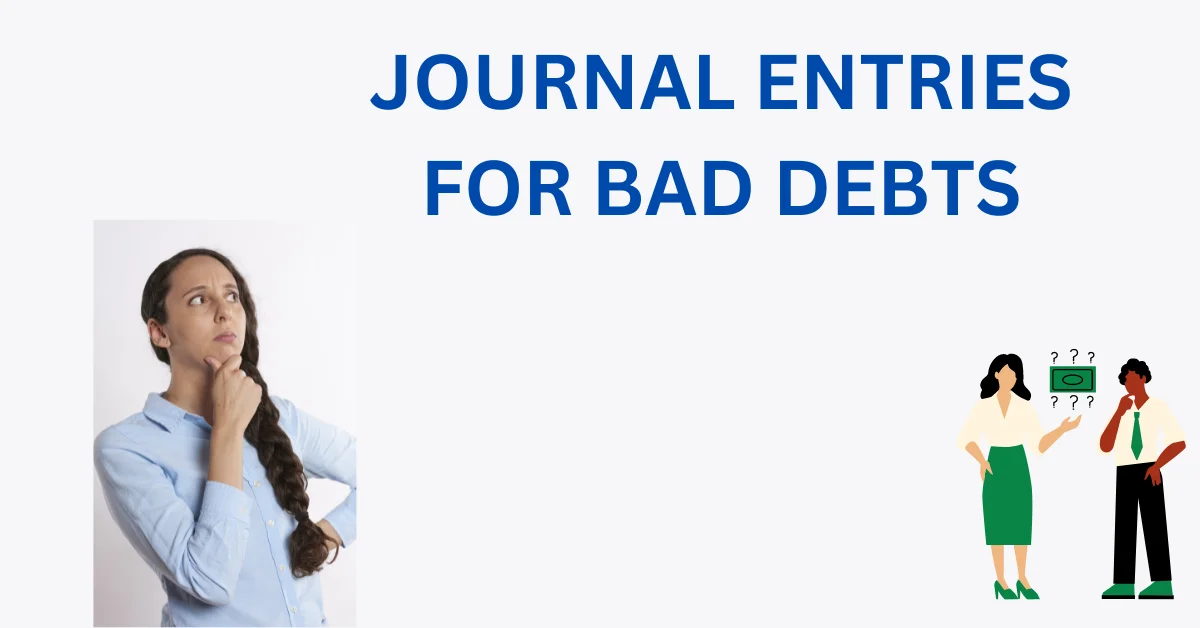In this article we will provide the information related to the Journal Entries for Bad Debts.
Bad debts refer to money that we are unable to collect from debtors. Sometimes, companies extend credit to our debtors by providing them with goods or money.
These debtors are supposed to repay the amount they owe, but when they fail to do so, it becomes a loss for our business. Consequently, we need to record the entry for bad debts, treating it like any other business loss.
All loss accounts will be debited, and any asset that decreases will be credited. In the case of bad debts, the following journal entries will be made:
JOURNAL ENTRY FOR BAD DEBTS LOSS
To record this journal entry, it is essential that a debt becomes uncollectible after we have made all reasonable efforts to collect it.
After exhausting all collection attempts and sending a final notice to the debtor without success, we can classify the debt as a bad debt.
Bad Debt Account Debit
Specific Debtor Account Credit
Example: Sham owes us Rs. 5,000, and Ram owes us Rs. 10,000, both of which have become uncollectible by the end of the financial year. These receivable amounts are classified as bad debt losses through the following entry:
Bad Debts Account Debit 15,000
Sham Account Credit 5,000
Ram Account Credit 10,000
JOURNAL ENTRY FOR WRITING OFF BAD DEBTS
Writing off bad debts involves closing the bad debt account by transferring the bad debt amount to the debit side of our profit and loss account.
When we include bad debts on the debit side of the profit and loss account, the bad debts account will reflect the same amount on its credit side, resulting in a balanced account with no balance to carry forward.
Profit and Loss Account Debit
Bad Debts Account Credit
Example: Sham owes us Rs. 5,000, and Ram owes us Rs. 10,000, both of which have become uncollectible by the end of the financial year. These receivable amounts are classified as bad debt losses and subsequently written off by transferring them to the profit and loss account:
Profit and Loss Account Debit 15,000
Bad Debts Account Credit 15,000
JOURNAL ENTRY FOR RECOVERED BAD DEBTS
When bad debts are recovered from a debtor after the close of our financial year, we treat it as income.
Similar to other incomes, recovered bad debts are also considered as income and credited to the relevant account. We debit the asset account that increases as a result of earning this income, such as our bank account, as we receive the money from our debtor.
Bank Account Debit
Bad Debts Recovered Account Credit
Example: Sham owes us Rs. 5,000, and Ram owes us Rs. 10,000, both of which became bad debts. In the financial year 2012, we received Rs. 6,000 from Ram and Rs. 2,000 from Sham on 7th June 2019.
7th June 2019
Bank Account Debit 8,000
Bad Debt Recovered Account Credit 8,000
- Journal Entry for Recovered Bad Debts Transferred to Profit and Loss Account
If we choose to transfer the recovered bad debts to the profit and loss account, we make an adjusting entry for it.
Bad Debts Recovered Debit
Profit and Loss Account Credit
Example: Sham owes us Rs. 5,000, and Ram owes us Rs. 10,000, both of which became bad debts. In the financial year 2019, we received Rs. 6,000 from Ram and Rs. 2,000 from Sham on 7th June 2019. At the end of 2019, we decided to transfer this amount to the profit and loss account.
31st Dec. 2019
Bad Debts Recovered Account Debit 8,000
Profit and Loss Account Credit 8,000.
